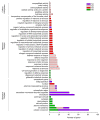New Insights into Bacillus-Primed Plant Responses to a Necrotrophic Pathogen Derived from the Tomato- Botrytis Pathosystem
- PMID: 36013965
- PMCID: PMC9416759
- DOI: 10.3390/microorganisms10081547
New Insights into Bacillus-Primed Plant Responses to a Necrotrophic Pathogen Derived from the Tomato- Botrytis Pathosystem
Abstract
Induced systemic resistance (ISR) is one of the most studied mechanisms of plant−microbe interaction and is considered a very promising alternative for integrated pest management programs. In our study, we explored the plant defense response induced by Bacillus velezensis BBC047 in relation to its application before or after Botrytis cinerea infection of tomato plants. The inoculation of BBC047 did not considerably alter the gene expression of the tomato tissues, whereas infection with B. cinerea in BBC047-primed plants induced expression of LRR and NBS-LRR receptors, which are highly related to the ISR response. As expected, B. cinerea infection generated molecular patterns typical of a defense response to pathogen infection as the overexpression of pathogenesis-related proteins (PRs) in leaflets distant to the point of infection. The curative treatment (P + F + B) allowed us to gain insights into plant response to an inverted priming. In this treatment, B. cinerea caused the m tissue damage, extending nearly entirely across the entire infected leaves. Additionally, genes generally associated with early SAR response (<16 h) were overexpressed, and apparently, the beneficial strain was not perceived as such. Therefore, we infer that the plant defense to the curative treatment represents a higher degree of biological stress triggered by the incorporation of strain BBC047 as second arriving microorganism. We highlight the importance the phytosanitary status of plants prior to inoculation of beneficial microorganism for the biocontrol of pathogens.
Keywords: ISR; PGPR; biocontrol; priming; resistance induction.
Conflict of interest statement
The authors declare no conflict of interest.
Figures





Similar articles
-
Are Bacterial Volatile Compounds Poisonous Odors to a Fungal Pathogen Botrytis cinerea, Alarm Signals to Arabidopsis Seedlings for Eliciting Induced Resistance, or Both?Front Microbiol. 2016 Feb 23;7:196. doi: 10.3389/fmicb.2016.00196. eCollection 2016. Front Microbiol. 2016. PMID: 26941721 Free PMC article.
-
Priming of camalexin accumulation in induced systemic resistance by beneficial bacteria against Botrytis cinerea and Pseudomonas syringae pv. tomato DC3000.J Exp Bot. 2022 Jun 2;73(11):3743-3757. doi: 10.1093/jxb/erac070. J Exp Bot. 2022. PMID: 35191984
-
Function of miR825 and miR825* as Negative Regulators in Bacillus cereus AR156-elicited Systemic Resistance to Botrytis cinerea in Arabidopsis thaliana.Int J Mol Sci. 2019 Oct 11;20(20):5032. doi: 10.3390/ijms20205032. Int J Mol Sci. 2019. PMID: 31614458 Free PMC article.
-
Mechanisms and strategies of plant defense against Botrytis cinerea.Crit Rev Biotechnol. 2017 Mar;37(2):262-274. doi: 10.1080/07388551.2016.1271767. Epub 2017 Jan 5. Crit Rev Biotechnol. 2017. PMID: 28056558 Review.
-
Pathogenesis-Related Proteins (PRs) with Enzyme Activity Activating Plant Defense Responses.Plants (Basel). 2023 Jun 5;12(11):2226. doi: 10.3390/plants12112226. Plants (Basel). 2023. PMID: 37299204 Free PMC article. Review.
Cited by
-
Bacillus species as tools for biocontrol of plant diseases: A meta-analysis of twenty-two years of research, 2000-2021.World J Microbiol Biotechnol. 2024 Feb 27;40(4):110. doi: 10.1007/s11274-024-03935-x. World J Microbiol Biotechnol. 2024. PMID: 38411743
-
Preparation of Azoxystrobin-Zinc Metal-Organic Framework/Biomass Charcoal Composite Materials and Application in the Prevention and Control of Gray Mold in Tomato.Int J Mol Sci. 2023 Oct 26;24(21):15609. doi: 10.3390/ijms242115609. Int J Mol Sci. 2023. PMID: 37958590 Free PMC article.
References
-
- FAOSTAT. 2020. [(accessed on 28 December 2021)]. Available online: http://www.fao.org/faostat/en/#data/QC.
-
- Panno S., Davino S., Caruso A.G., Bertacca S., Crnogorac A., Mandic A., Noris E., Matic S. A review of the most common and economically important diseases that undermine the cultivation of tomato crop in the Mediterranean basin. Agronomy. 2021;11:2188. doi: 10.3390/agronomy11112188. - DOI
Grants and funding
LinkOut - more resources
Full Text Sources
Research Materials
Miscellaneous

